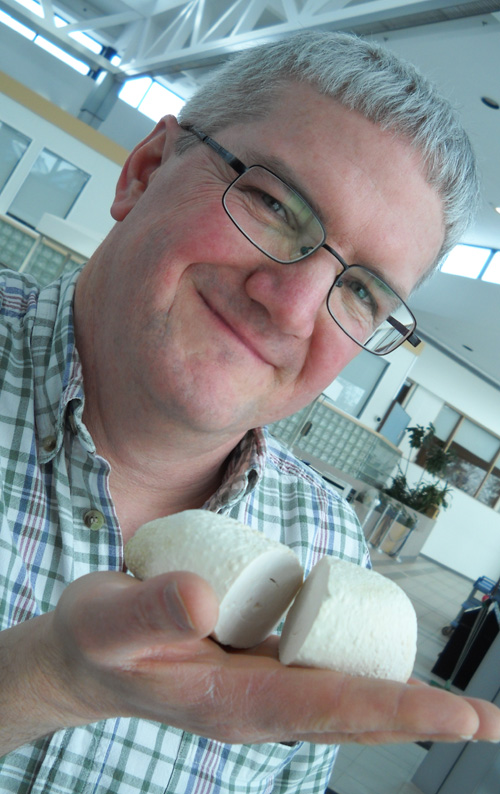
Picture a bladder stone big enough to fill a man’s palm. Andrew Moore doesn’t have to imagine. That’s the size of the largest samples he has seen arrive over the past 15 years for testing in U of G’s Laboratory Services.
Large or small, if your pet’s bladder stone was removed in a Canadian veterinary clinic, chances are that it came to Guelph for analysis.
Since 1998, the Canadian Veterinary Urolith Centre (CVUC) has received thousands of stones extracted from dog and cat bladders – more than 100,000, to be exact. That benchmark was passed in late January. Quips Moore, supervisor of analytical microscopy with the unit: “It’s a bit of a milestone.”
The centre tests those samples for client veterinarians in Canada and a handful of other countries, and makes dietary recommendations to help pet owners prevent recurrence of the problem. The analysis program is funded by Royal Canin Canada, a specialty pet food company based in Guelph.
The CVUC looks at about 9,000 stones each year from about 1,800 vet clinics across Canada. Samples also come from Hong Kong, Australia, Iceland, Denmark and the United Arab Emirates.
When the service began, Moore — a two-time Guelph grad — was the centre’s only occupant in Lab Services’ microscopy section. Now, five full-time technicians process samples here.
Bladder stone testing takes up about half of the unit’s time. The group also tests food samples for foreign materials, sometimes working along with the Animal Health Laboratory on animal poisoning cases.
About eight out of 10 of those stones come from dogs. Some canine breeds are prone to developing bladder stones, including Newfoundlands, bulldogs and wolfhounds. The largest fist-sized stones likely came from a Labrador retriever or a Rottweiler, says Moore. Dalmatians carry a genetic mutation that makes them susceptible to forming urate-based stones.
Among cats, urate bladder stones are more common among such breeds as Egyptian Maus and Ragdolls; Himalayans are prone to calcium oxalate stones.
Team members use various kinds of microscopes — light, infrared and scanning electron instruments – to examine stones. They look for various compounds and elements, including calcium, oxalate, magnesium, ammonium phosphate, uric acid and cysteine.
Test results are provided to client veterinarians within five days.
Any veterinarian may send samples to Lab Services. In return, the veterinarian receives a comprehensive report, including information about the stone’s mineral composition and recommendations to prevent recurrence.
Although the dietary recommendations refer specifically to Royal Canin products, no veterinarian or clinic is obligated to buy from the company. Besides diet, recommendations may include drugs and lifestyle changes, even increasing water intake.
Royal Canin provides funding each year to run the program. The program was begun by an earlier company, Veterinary Medical Diets, which was purchased by Royal Canin.
Before that, quantitative stone analysis was unavailable in Canada, says Johanne Pelletier, a veterinarian and the company’s scientific communications director.
Through the service, she says, “We can have a clear understanding of the nature of the problem or stone and can therefore make the best recommendation for managing this condition. The pet owner can then do what is recommended to reduce the risk of recurrence.”
The centre has supported research projects by grad students in the Ontario Veterinary College.
One study looked at stones caused by foreign bodies such as sutures lodged in the bladder. Another compared stones from animals across Ontario to look for connections to local conditions such as water hardness.
Says Pelletier, “With the data collected from the CVUC, Royal Canin has published a number of papers related to urinary tract diseases in cats and dogs, and we are recognized as experts on the topic. The information and knowledge acquired through this service has enabled us to continuously improve our formulas and the lives of pets.”
A new paper co-authored by Moore assesses 15 years’ worth of data from the program.
An ecology and botany grad of Guelph, he says he’s always loved microscopy. He joined Lab Services in 1992.
He has a mixed-breed dog and two mixed cats; none have suffered from bladder stones. “I’ve learned through the years which dogs you might not want to own because they’re more prone to stones.”